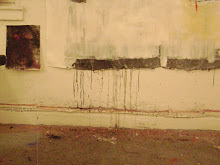
During my years home-based about twenty minutes outside of Philadelphia, the Philadelphia Museum or Art was a frequent weekend trip. After many visits, the open staircase felt like home as did the galleries on galleries of artwork. Cezanne's bathers were there, splashing it up and catching the shade. My favorite Picasso still life hung in the Cubist gallery for years. Duchamp's early work untouched by Dada and its anti-war, anti-art sentiment. Brancusi's "Bird in Space" lined up next to other soft, organic sculpture. The voluptuous ladies of Renoir - creamy, rosy skin peeking out from plants and flowers.
The piece above hangs in a very central location. In front of it, rows of wooden chairs. A small group of classical musicians seated in front of the painting once, played for the guests seated in front of the dismal scene of Christ and the Madonna.
We all know the scene. Christ, hanging on the cross, lifeless. His mother, overcome with grief and sadness laying, kneeling at his feet. This painting is done as two panels. Could one be shown without the other? Physically it is possible of course. Would there be a purpose in showing them separately? Not in my opinion. The connecting element in this painting or paintings is the fabric of Mary's gown. It works as an arrow, coaxing the viewer as he moves from left to right. It is night but yet there is an incredible light, illuminating the scene. Does it come from above? No shadows are cast. Then there is the wall creating a sense of isolation, abandonment. Mary's head is bowed and Christ's bowed head answers it. Another connection over the two panels.
Is the wind blowing? The scene feels still, quiet, but yet the fabric of Christ's covering is moving with the breeze. The painting is sparse but very powerful, proving that sometimes the most minimal of scenes can convey the greatest emotion and feeling.


0 Comments:
Post a Comment
<< Home